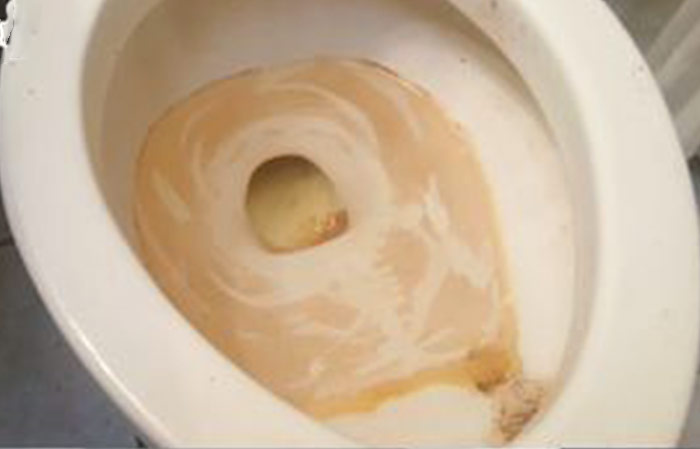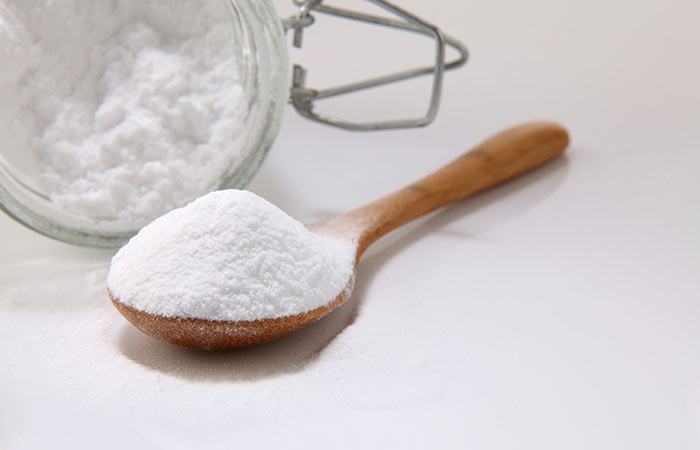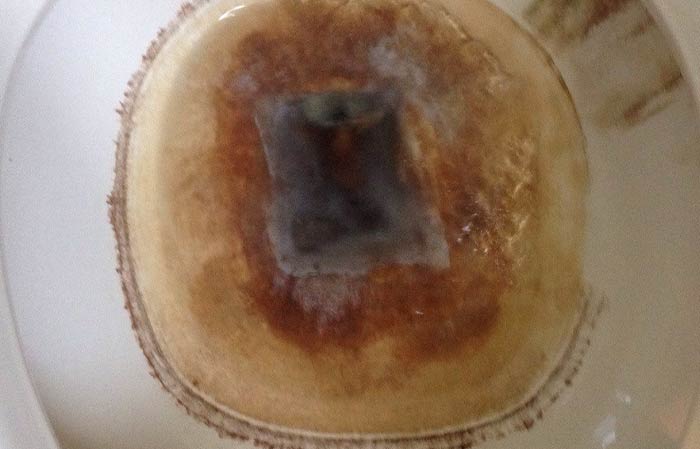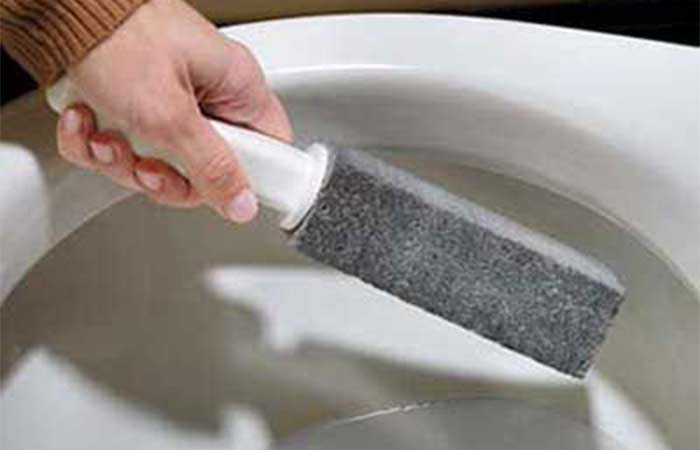How to Remove Brown Hard Water Stains in Toilet Bowl Bottom & Walls
The unsightly brown stains in your toilet bowl bottom walls are mostly brought about by the buildup of minerals in the water supply, accumulation of dirt, grime, or rust.
To remove the brown stains your toilet bowl, use a toilet bowl cleaner, a mixture of baking soda and vinegar, bleach or pumice stone that contains bleach or a pumice stone. Regular cleaning and maintenance of your toilet can help prevent brown stains from forming in the first place.
Following is an in-depth guide on the causes, solutions, and some preventative ideas to keep your toilet fresh and free from unnecessary staining.
What Causes the Brown Stains in Toilet Bowl?
The following are some of the possible causes.

1. Iron/ Manganese In the Water
The red-rusty stains you see in your toilet are majorly contributed to the type of water you have in your bathroom; hard water. This water tends to leave an abundance of mineral deposits in the bowl, in the tank, behind the tank, and even underneath the toilet.
The hard water encourages metal pipes to rust easily, therefore, giving off iron sediments, which then settle in the water as a ring or tiny particles settle at the base of your toilet bowl.
A deep brown colored stain could indicate the presence of manganese, which is also a very water-reactive metal that causes the toilet to have brown streaks, especially where the siphon jets release water from. The best solution for such a case is to have a filtering system that’ll remove these heavy metals(iron and manganese) from the main water supply.
2. Old or Damaged Piping Systems
Another factor that highly contributed to hard water brown stains is the type of piping you have. For most homes, the water and sewer services are connected through metal pipes.
This means that over time, the water passing through the pipe will start to get discolored as it picks up metal elements from the pipe coating.
You will evidently see this when you’re flushing the toilet and the water that trickles down is not entirely clear. A filter system is an excellent solution, where the water will be cleaned out before reaching your home. You could also replace the old corroded pipes, maybe consider PVC pipes.
3. Electrolysis
This is where dissimilar metals get in contact and cause staining. You can see this in two areas; the bathroom heater since the heating metal is brass but the piping is most probably copper.
The same case for the toilet, remodeled houses can have a mix of metals from galvanized, copper or PEX. So when the water comes through, the two metals will cause the water to turn hard, therefore, staining the toilet bowl.
Treating the water or flotation may not entirely help in this situation. You may have to get a plumber to fix the piping in the home. Chloramine could also cause adverse effects on the pipes making them corrode easily and making the problem even worse.
How to Remove Brown Stains in the Toilet Bowl
There are several methods you can use to get rid of these mineral deposits from the toilet bowl. All these elements tend to be reactive and hence offer the best remedy for removing the stains. Here are the top three methods you can use to remove these stains:
What you will need
These are the standard tools you will need for the job.
- Rubber gloves
- Rags
- Bleach
- Vinegar
- Borax
- Baking soda
- Wrench brush
- Sandpaper/Pumice Stone
- Hand brush
- Mineral oil
- Coke
- Bucket/ container
Option One: Baking Soda and Vinegar
A mixture of baking soda and vinegar tends to generate a chemical compound called carbonic acid, which is aggressive on stains and mineral deposits on surfaces. It will be an excellent remedy for this problem.

Method
- Measure about a cup of vinegar and pour it into the toilet bowl. Swish it around so it gets to every area in the bowl.
- Let it sink in the bowl for about half an hour to one hour.
- After that time, open the box of baking soda and sprinkle it all over the toilet. The vinegar you added previously will ensure it sticks to the walls of the bowl.
- Add some vinegar to activate a fizzy reaction.
- Let it fizz for another 15 minutes m, then come back and brush the interior surface of the toilet bowl.
- Scrub the toilet with a nylon stifle brush and rinse off by flushing. The toilet should be stain-free.
You can repeat this method as many times as possible. You can even leave the solution overnight to let it work through the tougher stains.
Option Two: Borax and Vinegar
Another chemical agent – borax is also great at multipurpose cleaning, especially on really tough stains. A mixture with vinegar only makes it better.
Method
- Add about a cup of borax into the toilet bowl.
- Add some vinegar right over the borax.
- Gently scrub the toilet. Let sit for 15 minutes and flush the look as you scrub again.
Option Three: Borax Paste
For those really stubborn stains, a borax paste should do the trick. Here’s how you can do that;
Method
- Wipe down the toilet bowl to get a clear view of where the mold is.
- Make a paste in a dish using borax and water. Ensure the paste is thick enough to stick on the walls of the bowl.
- Apply the paste over the hard-stained areas and scrub gently with the hand brush to make sure the paste is all over the bowl.
- Leave it on for half an hour.
- Once back, scrub again gently to scrape off the brown stains.
- Flush the toilet to finish up.
You can replace the water with vinegar in case you want a more reactive solution. Just ensure you add only a little amount so the borax can still mount on the wall.
Brown Stains/Sediments in the Bottom of Bowl
In some cases, you will see that the brown stains are below the waterline. They appear as sediments beneath the bowl right at the base.

How Do the Sediments Come About?
Unlike the rings, the sediments that settle on the base of the toilet come with a different story. When water comes out from the water tank, the piping could have rust stains, as well as the tank itself. Hence, these rusted areas release flakes that trickle down with the water every time you flush.
Since they’re pieces of metal, they tend to settle down at the base of the toilet bowl rather than flush down the drain. After some time settling at the base, they etch onto the Porcelain in a way that can easily be removed.
Here are five ways to get rid of the brown sediments.
Method #1: Vinegar
Vinegar is acidic in nature which makes it the best remedy for this job. It will simply soften the stain enough for you to scrape it off and also lift the build-up from the base of the toilet bowl. Here are the steps to follow.
Steps
- Measure one little of undiluted vinegar in a container or jug.
- Heat it up to over 120 degrees Fahrenheit to get the liquid activated.
- Pour it into the bowl with a keen eye around the sides and on the base where the sediments have settled.
- Leave it for as long as you’d like from an hour to even overnight.
- Scrub the bottom of the bowl to remove the brown sediments.
If you can’t clearly see the bottom of the bowl, you can begin by emptying the bowl using rags, then directly pour over the hot vinegar onto the sediments.
Method #2: Use Sandpaper/Pumice Stone
Your next option is to scrub the base gently using sandpaper or pumice stone. It’s just like a brush but tougher. Be sure to keep the stone wet while using it, and be careful not to scratch the toilet bowl.

Steps
- Empty the toilet bowl so you can reach for the bottom of the bowl and feel for the sediments.
- Gently run the stain off using the sandpaper/pumice stone in a consistent motion, front to back. Do not press too hard as it may scratch the bowl and damage it.
- Buff the area and wipe it off with a rag as you continue. When done, apply the mineral oil for a smooth finish.
Method #3: Baking Soda and Coca Cola
Coca-cola is fizzy in nature but it has several ingredients such as carbonic acid and citric acid, that allow it to be used to clean out stains from the toilet.
Steps
- Measure about a cup of baking soda and sprinkle it inside the toilet bowl.
- Pour the Coke directly on top of the baking soda to engage a chemical reaction.
- Let it sit for sometime like an hour and come back for some scrubbing.
- Scrub gently and flush the toilet for a quick rinse.
- The bottom of the bowl should be sparkling clean.
Method #4: Baking Soda and Vinegar
Steps
- Empty the toilet bowl using rags.
- Wipe down the walls of the toilet bowl until they are dry from water.
- Sprinkle adequate baking powder inside the toilet with precision to the bottom of the bowl.
- You could also make a paste in a dish using baking soda and vinegar. Ensure the paste is thick enough to stick on the walls and the base.
- Otherwise, use sandpaper and scrub the base using the baking soda only.
- Now add in the vinegar and let it react for some time.
- Once back, scrub the base of the toilet to ensure you get every single sediment from there.
- Wipe down with a rag to see if it needs further scrubbing. Continue until you have your results.
- Flush the toilet for a clean finish.
This solution can also be left overnight in cases where the sediments or stains at the base of the toilet are severe and need much more attention.
Method #5: Vinegar and Lemon Juice
Lemons produce citric acid which is a cleaning agent naturally. It can be a great replacement for baking some as they will react the same way, but not as aggressively. Because the lemon is used in juice form, simply mix the two ingredients together and repeat option one above.
How to Prevent Brown Stains in Toilet
After a hard day’s work scrubbing the toilet, you may want to adhere to some easy-peasy rules to ensure you’re not staining just as much to clean your toilet. Here are a few preventative measures you can use to keep the toilet clean and free from hard water stains.
- Regular cleaning: ensure you are thoroughly cleaning every area in the toilet to avoid any build-up or the possibility of stains etching on the Porcelain surface.
- Check the level of hardness of the water so you can select a corrective measure such as a filter or a treatment plant.
- Replace any old pipes or toilet fittings early.
Further Reading